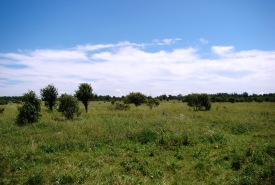Alvars 101

Carden Alvar, ON (Photo by NCC)
What are alvars?
Alvars are naturally open habitats with either a thin covering of soil or no soil over a base of limestone or dolostone.
Their unique geologic and physical characteristics set the stage for natural communities that simply cannot exist elsewhere.
Where are alvars found?
Globally, alvars are restricted to islands off the coast of Sweden, the eastern European Baltic region, the United Kingdom and Ireland.
In North America, almost 75 percent of these alvars are located in Ontario.
What are the different types of alvars?
The five main alvar types are:
- alvar shrublands
- alvar grasslands
- alvar savannahs
- alvar pavements
- alvar woodlands
What species live in alvars?
One report has estimated that up to 1,000 species of insects may be unique to alvar habitats, and several species of terrestrial mollusks are only found on alvar sites.
In fact, one of the most fascinating aspects of alvars is that they are among the most species-rich communities in the world at a small scale (less than 100 square centimetres).
Many alvars contain a multitude of listed and globally imperilled species, including rare invertebrates and the globally endangered eastern loggerhead shrike.
What is NCC doing to protect alvars?
In Ontario, the Nature Conservancy of Canada (NCC) has been actively working to protect the Carden Alvar for several years. Carden Alvar supports no fewer than 450 plant species, 142 butterfly and dragonfly species and 238 bird species.
In June of 2015, Manitoba became the first province to designate the alvar ecosystem as endangered under the Endangered Species and Ecosystems Act. Read more about alvars in Manitoba.




